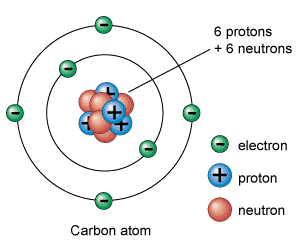[/caption]We know that atoms are parts of an element that can not naturally be broken down any further. What is the atom structure, though? The concept that atoms existed was first written about in ancient India in the 6th century B.C. The theory stayed just that, a theory, until the late 19th century. As microscopes and spectrometers developed, scientists were better able to develop their theories and finally observe the small scale structure of elements.
Atoms are made up of three particles: protons, electrons, and neutrons. Electrons are the smallest and lightest of the the three particles and they have a negative charge. The protons are much heavier and larger than electrons. Protons have a positive electrical charge. Neutrons are as large and massive as protons, but do not have an electrical charge at all. Every atom contains these particles in varying numbers. To understand exactly how small an atom is, you have to know that a single hydrogen atom is 5 x 10-8mm in diameter. It would take at least 60 million hydrogen atoms to fill the space of any one of the letters on this page.
The simplest atom is that of hydrogen: 1 electron and one proton. In every stable, neutrally charged atom there is the exact same number of protons as electrons. These particles work together like two magnets with the opposite electrical charges attracting each other. The reason that they do not crash together is that the electron is constantly revolving around the nucleus(usually a proton/neutron combination, but hydrogen, uniquely, does not contain any neutrons). The centrifugal force of the electron keeps it in place at a constant distance from the nucleus. Actually, representing the electron as spinning around the nucleus is somewhat misleading. Electrons act like waves. That is how they are seen on a spectrometer. It is just easier to think of them as spinning around.
Atoms can have an electrical charge, positive or negative. This happens when an atom gains or loses electrons. The number of protons never changes in an atom. More electrons means a negative charge and fewer means a positive charge. Once an atom has an electrical charge it is called an ion. In an ion the atomic number and atomic mass do not change from the original. If an atom were to gain or lose neutrons it becomes an isotope. Remember the hydrogen atom I mentioned earlier. It did not have a neutron attached to its proton. If it gains a neutron it become an isotope called deuterium. Since the atomic mass is the total of the number of protons and neutrons, an isotope would have a different atomic mass, but the same atomic number as the original atom.
Alright, that is a very basic rendition of atom structure. The University of Colorado has an interesting website to help you understand more complex versions of atoms. Here on Universe Today we have a great article about the many theorized models of the atom. We discussed ions. Astronomy Cast offers a good episode about interstellar travel using ion propulsion.
Sources:
Wikipedia
GSU Hyperphysics

